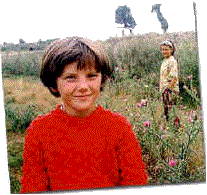Thanks for your interest in
our project !
Not all the pages of the original
site (in French) could be translated. If you can, have a look at the french
version.
Armand
 In
our October conference, we had choosen this picture to illustrate our Educators'
Conference on Kosovo. The little girl in the red sweater became the symbol of
our action to help reconstruct education in that part of the world. Eric (Causes
Communes), who took the picture in early July, did not know much much about
her. All he could tell us was that the picture had been taken in a small
village called Gllarevė - between Pristina and Peja.
In
our October conference, we had choosen this picture to illustrate our Educators'
Conference on Kosovo. The little girl in the red sweater became the symbol of
our action to help reconstruct education in that part of the world. Eric (Causes
Communes), who took the picture in early July, did not know much much about
her. All he could tell us was that the picture had been taken in a small
village called Gllarevė - between Pristina and Peja.
Two days before leaving to Kosovo in early
december, I received a note from Watts Rozell (Kosovo
Connection), who had organized the conference: "If you can find out as
much as you can about the girl on the conference picture... " So on
December 8th Pascal (Le Soir) and I embarked
on a C130 of the belgian army, en route to Kosovo. Our mission: find the
little girl in the red sweater !
We spent one week there, going from Leposavic to
Dragash, from Mitrovica to Peja. We met teachers and their classes. We met
school directors and community leaders in both the serbian and the albanian
parts of Kosovo. We met NGOs and official organizations who are currently
reconstructing schools there. At the end of our stay we located the Gllarev
village. And we found the little girl in the red sweater.
Her
name is Shqipe. Meeting her and her family was one of the very emotional moments
in our trip. But we also met many other boys and girls in all sorts of schools.
In the serbian-speaking part of Kosovo we visited a "large" school in
Leshak, and a little mountain school at Belobrdė, half-a-mile from the serbian
border. We saw big schools in cities like Pristina, Gjakova or Peja, but also
tent schools in villages like Cabra, that had been completely destroyed.
Whatever language they speak, all the children we
saw there hold the key of the future for Kosovo. Their teachers have an
important responsibility. So do all the people who can decide to help them, or
not. Even if the material conditions there are sometimes very difficult, what
they need is much more than money. This was my first trip to Kosovo, and I have
learnt much in just a few days. What we see on TV, what we read in newspapers,
cannot give us a right understanding of the reality there. But after this trip,
I am even more convinced than before that an action at the level of a specific
class or school, like a class twinning program, is probably one of the most
effective ways we have to help Kosovo integrate a community founded on the
democratic values of tolerance, openness to other cultures, and responsible
solidarity.
Armand
 In
our October conference, we had choosen this picture to illustrate our Educators'
Conference on Kosovo. The little girl in the red sweater became the symbol of
our action to help reconstruct education in that part of the world. Eric (Causes
Communes), who took the picture in early July, did not know much much about
her. All he could tell us was that the picture had been taken in a small
village called Gllarevė - between Pristina and Peja.
In
our October conference, we had choosen this picture to illustrate our Educators'
Conference on Kosovo. The little girl in the red sweater became the symbol of
our action to help reconstruct education in that part of the world. Eric (Causes
Communes), who took the picture in early July, did not know much much about
her. All he could tell us was that the picture had been taken in a small
village called Gllarevė - between Pristina and Peja.